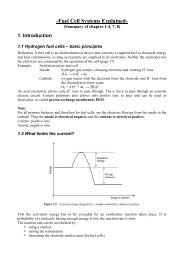Chapter 8. ORGANIC SOLAR CELLS - from and for SET students
Chapter 8. ORGANIC SOLAR CELLS - from and for SET students
Chapter 8. ORGANIC SOLAR CELLS - from and for SET students
You also want an ePaper? Increase the reach of your titles
YUMPU automatically turns print PDFs into web optimized ePapers that Google loves.
<strong>SOLAR</strong> <strong>CELLS</strong> <strong>Chapter</strong> 7. Thin-Film Silicon Solar Cells<br />
attention upon the increase of the deposition rate. Several new deposition methods 17 have<br />
been investigated <strong>for</strong> fabrication of solar cells at high deposition rates (0.5 to 1.0 nm/s), such<br />
as very high frequency <strong>and</strong> microwave PECVD, hot wire CVD, <strong>and</strong> exp<strong>and</strong>ing thermal<br />
plasma CVD.<br />
7.3 Hydrogenated amorphous silicon<br />
In order to underst<strong>and</strong> design <strong>and</strong> operation of an a-Si:H solar cell, which is different<br />
<strong>from</strong> a crystalline silicon (c-Si) cell, the material properties of a-Si:H are summarised <strong>and</strong><br />
compared to the single crystal silicon.<br />
7.3.1 Atomic structure<br />
Figure 7.1 illustrates the difference in the atomic structure between single crystal<br />
silicon <strong>and</strong> a-Si:H. Figure 7.1a shows the structure of single crystal silicon schematically.<br />
Each Si atom is covalently bonded to four neighbouring Si atoms. All bonds have the same<br />
length <strong>and</strong> the angles between the bonds are equal. The number of bonds that an atom has<br />
with its immediate neighbours in the atomic structure is called the coordination number or<br />
coordination. Thus, in single crystal silicon, the coordination number <strong>for</strong> all Si atoms is four;<br />
we can also say that Si atoms are fourfold coordinated. A unit cell can be defined, <strong>from</strong> which<br />
the crystal lattice can be reproduced by duplicating the unit cell <strong>and</strong> stacking the duplicates<br />
next to each other. Such a regular atomic arrangement is described as a structure with long<br />
range order. A diamond lattice unit cell represents the real lattice structure of single crystal<br />
silicon.<br />
Figure 7.1b illustrates that a-Si:H does not exhibit the structural order over a longrange<br />
as is the case <strong>for</strong> single crystal silicon. Nevertheless, there is a similarity in atomic<br />
configuration on a local atomic scale, where most Si atoms have covalent bonds with four<br />
neighbours. The a-Si:H has the same short-range order as the single crystal silicon but it<br />
lacks the long range order. The small deviations in bonding angles <strong>and</strong> bonding lengths<br />
between the neighbouring atoms in a-Si:H lead to a complete loss of the locally ordered<br />
structure on a scale exceeding a few atomic distances. The resulting atomic structure of a-<br />
Si:H is called the continuous r<strong>and</strong>om network. Due to the short-range order in the<br />
continuous r<strong>and</strong>om network of a-Si:H, the common semiconductor concept of the energy<br />
states b<strong>and</strong>s, represented by the conduction <strong>and</strong> valence b<strong>and</strong>s, can still be used.<br />
The larger deviations in bonding angles <strong>and</strong> bonding lengths between the<br />
neighbouring atoms in a-Si:H result in the so-called weak or strained bonds. The energy of<br />
the weak bonds is higher than the energy of optimal silicon covalent bonds in ideal single<br />
crystal silicon. There<strong>for</strong>e, the weak bonds can easily break <strong>and</strong> <strong>for</strong>m defects in the atomic<br />
network. We note that in the continuous r<strong>and</strong>om network, the definition of a defect is<br />
modified with respect to the crystal structure. In a crystal any atom that is out of place in a<br />
lattice <strong>for</strong>ms a defect. In the continuous r<strong>and</strong>om network an atom cannot be out of place.<br />
Because the only specific structural feature of an atom in the continuous r<strong>and</strong>om network<br />
17 R.E.I. Schropp <strong>and</strong> M. Zeman, Amorphous <strong>and</strong> Microcrystalline Solar Cells: Modeling, Materials, <strong>and</strong><br />
Device Technology, Kluwer Academic Publishers, 199<strong>8.</strong><br />
- 7.4 -






